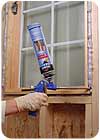

“Initiatives like the U.S. government’s Energy Star Labeled Homes Program and IRS tax credits for energy saving enhancements currently provide financial incentives for builders to build more energy efficient buildings,” explains Dr. Tom Fishback, technical director of Norton, OH-based Fomo Products, Inc. “The International Energy Conservation Code (IECC) is enforced in various regions of the country with some success. A number of states (North Carolina, Colorado, and Nevada, among others) have adopted their own energy codes that set the bar even higher than IECC standards. And with current energy conservation a major topical concern, committees have already been formed to propose even tougher energy standards for the 2009 International Residential Codes (IRC). These committees will focus on setting code standards that will greatly reduce air infiltration and exfiltration in residential and commercial buildings, which the Dept. of Energy states is responsible for up to 40% of energy loss in buildings. Tighter, more energy efficient buildings will require the increased use of sealant and caulking materials that will connect all of a building’s components into a monolithic air barrier structure.
ASTM E 283 is the accepted standardized test method for air barrier components and systems. This test determines the rate of air leakage through a material under a specified pressure difference across the specimen. Measurements using ASTM E 283 show that Fomo’s Handi-Foam, when properly applied, reduces the air leakage rate to less than 0.01 cubic feet per minute per square foot (0.05 Liters/second/square meter), which is below accepted building code requirements. The actual test results for Handi-Foam One and Two-Component foam and Handi-Seal Window and Door Sealant are as follows.
Air Leakage rate at:
1.57 psf (75 Pa) pressure differential = ‹0.01 cfm/ft2 (0.05 L/s/m2)
6.24 psf (300 Pa) pressure differential = ‹0.01 cfm/ft2 (0.05 L/s/m2)
These results show that Handi-Foam One-Component and Two-Component froth foam systems - with their unique ability to expand, bond, and seal - provide an excellent barrier against air infiltration.
“The ‘stack effect’ (warm air rising) creates pressure differentials within a building that pull outside air into the structure through any gap or crack that is not sealed with an air barrier material,” says Fishback. “Areas particularly vulnerable to sealing issues are around windows, doors, skylights, plumbing and electrical penetrations, rim joists in homes, and the area between floors in commercial buildings.”
Numerous scientific studies have shown that energy usage can be dramatically reduced by sealing against unwanted air infiltration (as much as 55% reduction in air leakage rate @ 50 Pa pressure differential is common). The U.S. Dept. of Energy (DOE) supports research dedicated to meeting its goal of reducing energy consumption in buildings 25% by 2020 and 50% by 2030. The DOE states that up to 40% of heating and cooling costs are due to air infiltration in the building envelope.
A recent NAHB study (1997) showed that a good caulk-and-seal (foam-and-seal) package reduces annual heating and cooling costs from $150 - $300, on average. An effective air barrier also prevents most damage done to buildings associated with moisture. Most of the moisture (90%) that ingresses into the building envelope is carried by air. Airborne moisture can condense on colder surfaces, leading to rot and deterioration of the substrate, and providing a necessary growing condition for mold. Thus, Handi-Foam products are important components of an air barrier system that helps prevent decay, deterioration and mold. Building scientists, specifiers and builders are convinced that an effective air barrier is the most cost-effective way to create durable, healthy, energy-efficient buildings.
“Fomo Products offers the widest selection of polyurethane foam insulation and sealant products in the business, each of which is packaged with the industry’s most efficient and effective dispensing tools,” Fishback says. “We have products that meet all relevant building codes and material standards for polyurethane foam insulation and sealants in construction. Along with being an ISO 9001-certified company, Fomo Products has the distinct reputation of having the highest quality products and most extensive technical service in the industry. Our significant financial investment in R&D makes us a recognized leader in the building products industry through our constant introduction of innovative polyurethane foam products for energy and water management of the building envelope.”
For more information, visit www.buildingscience.com/default.htm, www.nibs.org, www.airbarrier.org, or www.eeba.org/.